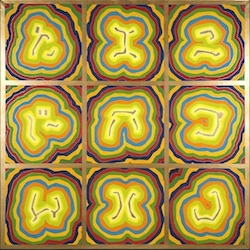|
ICONS & POP ART
By GUSTAV WAGNER Published: Thursday, 11 October 2012 |
|
 Throughout history, many cultures have used art, typically in the form of icons, as instruments of worship. Two of the most grandiose of such expressions were Czarist Russia and Western Europe during the Renaissance. The Renaissance was a cultural movement that originated in Florence, Italy in the 14th century and was partly influenced by Islamic culture. Spain was conquered by Arab and Berber forces in the early 8th century during the first wave of Islamic expansion. During the several centuries that followed the conquest, "Spain's agricultural economy was one of the most prosperous in Europe, and the right turn of events contributed to a brilliant high culture in which astronomy, medicine, the arts, architecture, and literature flourished"(Strayer, 322). Part of this cultural influence found an expression in the Renaissance in the form of opulent iconic representations. Typical examples were the figure of the Virgin Mary or that of a saint, which would be adorned with golden robes as a statement of their holiness and importance.
Throughout history, many cultures have used art, typically in the form of icons, as instruments of worship. Two of the most grandiose of such expressions were Czarist Russia and Western Europe during the Renaissance. The Renaissance was a cultural movement that originated in Florence, Italy in the 14th century and was partly influenced by Islamic culture. Spain was conquered by Arab and Berber forces in the early 8th century during the first wave of Islamic expansion. During the several centuries that followed the conquest, "Spain's agricultural economy was one of the most prosperous in Europe, and the right turn of events contributed to a brilliant high culture in which astronomy, medicine, the arts, architecture, and literature flourished"(Strayer, 322). Part of this cultural influence found an expression in the Renaissance in the form of opulent iconic representations. Typical examples were the figure of the Virgin Mary or that of a saint, which would be adorned with golden robes as a statement of their holiness and importance.
Fast forward a few hundred years to the 1950's in New York where we witness a resurgence of Renaissance motifs in the Pop artistic movement. One of the best representations of this is the "Gold Marilyn Monroe" by Andy Warhol. This particular work consists of an entire canvas painted in gold with an image of Marilyn Monroe's face placed in the center. The image is not painted but applied on the canvas as a silkscreen. In addition, the image is not in black and white but painted in very distinctive colors. The face is pink, the hair yellow, the lips red, and the eyes light blue. In his work, Warhol is making reference to the Renaissance tradition but with a contemporary twist. In his interpretation, he is elevating the everyday to the artistic level. He is taking the image of Marilyn Monroe, a well-known personality of the time, and fashioning it as an icon. With his golden canvas, Warhol makes allusion to the concepts of wealth and fame, for he "recognized that commodities and their human counterparts - celebrities - function as the icons of consumer society. . .The power of the contemporary icon lies not in its uniqueness - it is patently reproducible - but rather in its capacity to constitute a community through recognition and identification" (Joselit, 77).
Move forward another sixty years to Mariscotti's latest work, "Untitled Gold". In this work, Mariscotti also evokes the iconic tradition of the 14th century but with a different twist than Warhol. Mariscotti uses the gold for a twofold purpose. First, the gold brings his subjects to the forefront and elevates them, enhancing our perception of them. Second, the gold represents a very specific emotion in Mariscotti's interpretation: the feeling of joy (Wagner, 1). This connotation carries emotional feelings which, under the right circumstances, could also resonate with the viewer. "Untitled Gold" is thus not only a statement but an expression of the artist's life, imbued with conflict and change.
To conclude, we see how elements from the past have influenced the current development of art. However, this influence does not undermine the essence of the work as conceived by the artist. Instead, it complements and elevates the work with elements which have not only survived the test of time, but continue to find new meanings as expressions of a contemporary creative process.
Strayer, R. W. (2009). Ways of the World: A Brief Global History. Boston, MA: Bedford/St. Martin's
Joselit, D. (2003). American Art Since 1945. London, UK: Thames & Hudson Ltd
Wagner, G. (2012). Golden Canvas. MARISCOTTIART. Retrieved from http://www.mariscottiart.com/news.php?per=per1
- G.W.
comments powered by Disqus
| RELATED ARTICLES | |||||||||||
|
|
|
|
||||||||




